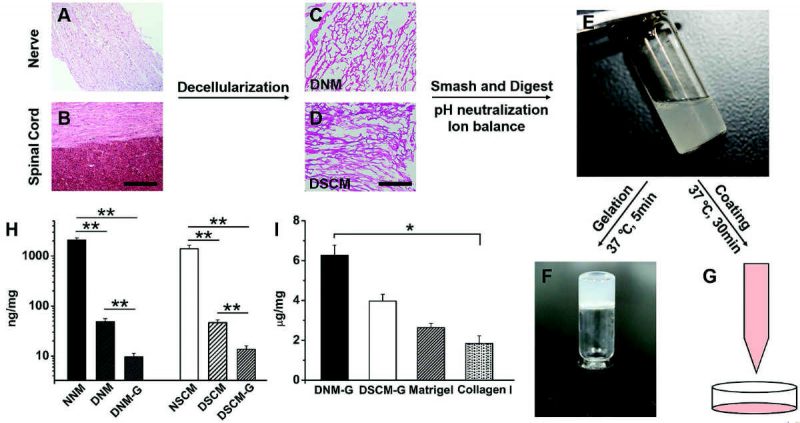|
外周神经源性基质水凝胶促进再髓鞘化及抑制突触的形成
Adv. Funct. Mater. 2018, 28, 1705739
神经组织损伤后的修复过程涉及轴突生长,再髓鞘化和突触形成等一系列复杂细胞生物学变化。中枢神经系统与周围神经系统在结构及功能方面存在着明显差异,对再生的需求也不相同。例如,大脑主要负责信息的分析处理,因此大脑损伤后的功能修复需要再生神经元之间形成大量突触连接,而坐骨神经主要负责信息的快速传递,其损伤修复过程更加依赖轴突髓鞘化,同时需避免轴突之间形成病理性突触连接。如何让神经修复材料具备”组织特异性功能”一直以来是再生医学界的难题。 近日,中山大学全大萍教授和曾园山教授团队联合报道了一种去细胞神经基质水凝胶材料(Decellularized nerve matrix-gel,DNM-G)具备适合周围神经组织再生的功能特异性。以猪的坐骨神经为原材料,经化学脱细胞及酶消化等手段处理后制备的生物水凝胶主要包含了坐骨神经细胞外基质(extracellular matrix,ECM)成份。通过与去细胞脊髓来源的基质水凝decellularized spinal cord matrix-gel,DSCM-G,肿瘤组织ECM来源的水凝胶(Matrigel)以及I型胶原(collagen I)比较后发现,DNM-G能够特异性诱导体外培养的施万细胞沿着轴突迁移排列并包卷轴突,从而促进轴突髓鞘化。另一方面,DNM-G能够抑制突触后成份-PSD95的表达从而抑制突触形成。这些结果表现出明显的周围神经再生特征。脊髓来源的水凝胶DSCM-G虽然也能促进施万细胞贴附轴突,但施万细胞包卷轴突的方式更加类似无髓神经纤维。并且DSCM-G能够很好的支持体外培养DRG神经元相互之间形成突触,这些更加类似中枢神经的再生特点。这些研究不仅为周围神经损伤修复提供了一种良好的新材料,更重要的是为组织特异性生物材料的开发和改性研究提供了重要的方法和理论指导。 The regeneration process after nerve tissue injury involves a series of complex cell biological changes, such as axonal growth, re-myelination and synaptic formation. There are significant differences in structure and function between the central nervous system and the peripheral nervous system, and the need for regeneration is different. Brain, for example, is mainly responsible for the analysis of the information processing, so the function of the brain regeneration after injury need form a large number of synaptic connections between neurons, and the sciatic nerve is mainly responsible for rapid transfer of information, its regeneration process depends on axon myelin sheath, also need to avoid formation of pathological synaptic connections between axon. How to make nerve repair materials have “tissue specific function” has always been a difficult problem in regenerative medicine. Recently, Da-Ping Quan a professor at zhongshan university reported a cellular neural hydrogel matrix materials (Decellularized nerve matrix – gel, DNM – G) suitable for tissue regeneration of peripheral nerve function. The biohydrogels prepared by means of the sciatic nerve of pigs and processed by chemical deactivation and enzymatic digestion are mainly composed of extracellular matrix (ECM). DNM-G can specifically induce in vitro culture of schwann cells along the axonal migration and percolation of the scrolls, thereby promoting the axonal myelination. On the other hand, DNM-G can inhibit the expression of postsynaptic components -PSD95 and inhibit the formation of synapses. These results showed significant peripheral neurogenesis. The hydrogel DSCM-G derived from the spinal cord can also facilitate the attachment of axons to the schwann cells, but it is more similar to the unmyelinated nerve fibers. Moreover, DSCM-G can support the formation of synapses between DRG neurons in vitro, which are more similar to the regenerative characteristics of the central nervous system. These studies not only for the repair of peripheral nerve injury provides a good new material, which is more important for the development of tissue specificity of biological materials and modification research provides an important method and the theoretical guidance. (张逸)
|
